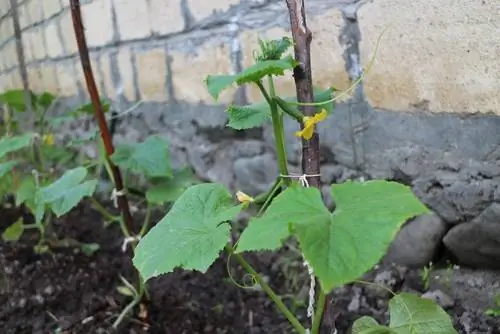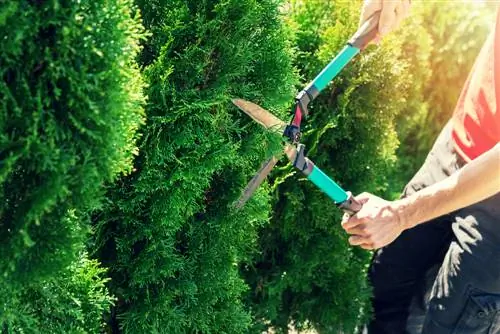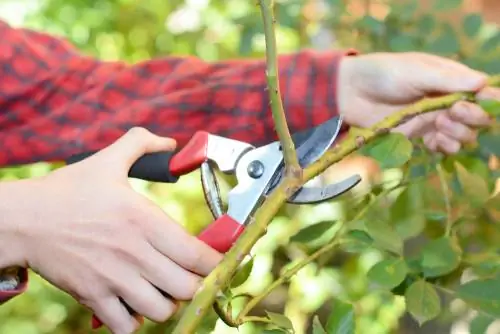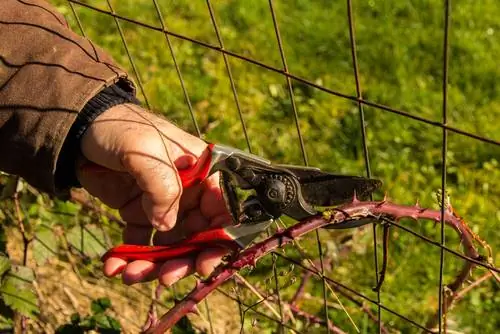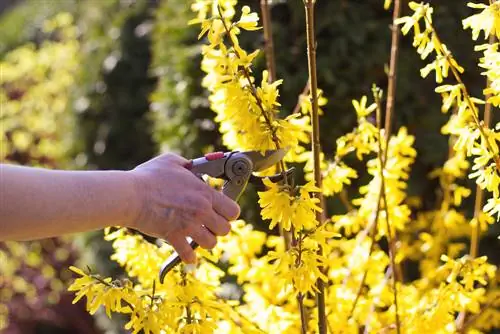- Author admin [email protected].
- Public 2023-12-16 16:46.
- Last modified 2025-06-01 06:02.
A thin line separates joy and sorrow when growing cucumbers. The path to a rich harvest is made up of important individual steps. These instructions explain clearly and comprehensibly how to plant cucumbers correctly. How to master the challenge with and without a greenhouse.
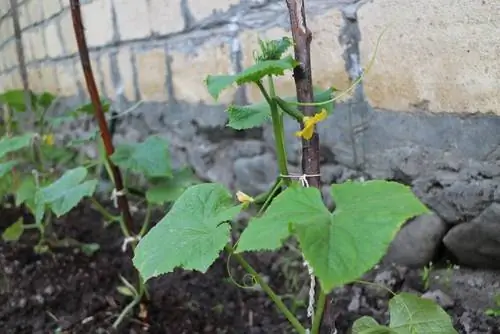
When should you plant cucumbers?
From April onwards, plant the cucumbers in the greenhouse or on the windowsill. The young plants don't go outdoors until mid-May. As heavy feeders, cucumbers need nutrient-rich soil. They need to be fertilized regularly. You should also plan a climbing aid made from a chain link fence or plant stakes.
Planting cucumbers in the greenhouse
Before you start planting, please assemble the chosen trellis. This prevents you from having to enter a freshly planted greenhouse bed later. How to properly plant cucumbers in the greenhouse:
- Enrich the soil with mature compost, manure or bark humus
- Dig planting pits at a distance of 40 cm (row spacing 120-140 cm)
- Soak the cultivation pots in water until no more air bubbles appear
- Remove the pot from the root ball
- Insert the cucumber plant in the middle, press down the soil and water
- Tie shoots to the climbing aid
- Mulching with grass clippings, nettle leaves or straw
How deep you plant depends on the cucumber plant in question. You should plant conventional species and varieties a little deeper so that additional roots form for optimized stability. Plant grafted cucumbers so deep that the thickened grafting area is above the ground.
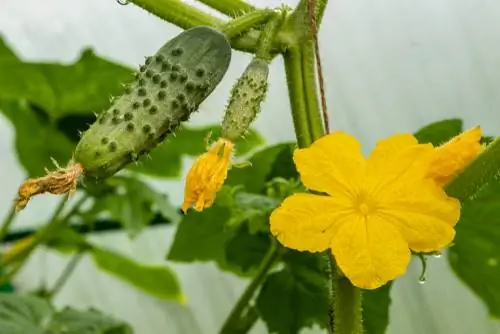
Cucumbers grow particularly well in the greenhouse
Locations beyond the greenhouse
Crispy home-grown cucumbers are within reach even for hobby gardeners without a greenhouse. Thanks to space-saving mini cucumbers, balcony gardeners can harvest aromatic fruits from their deck chairs. The following overview demonstrates the wide range of suitable locations beyond greenhouses and greenhouses:
- Balcony/terrace: pot, hanging basket or large flower box
- Outdoor: bed, raised bed, pot
When growing cucumbers outdoors, the focus is on all sun-drenched, wind-protected locations. In the cottage garden, this can also be a wooden fence facing south, which the tendrils will turn green in no time. In a natural garden, there is nothing to stop you from planting a climbing arch with roses and instead turning it into a growing area for cucumbers. Just let your imagination run wild.
Tip
If you plant cucumbers yourself, soil fatigue is a big issue. The following maxim applies: Crops from the same botanical family must not be grown one after the other. In the bed, raised bed and greenhouse, only a cultivation break of three years guarantees that the lovingly grown cucumber plants will thrive luxuriantly and will not languish. Alternatively, dig the leached soil two spades deep and fill the pit with fresh garden soil.
Outdoor planting - step-by-step instructions
If you plant cucumbers outdoors, modified specifications must be taken into account compared to those in the greenhouse. It will not be warm enough outside until after the Ice Saints in mid-May at the earliest so that young plants do not suffer any cold shock. If in doubt, measure the soil temperature, because the signals only turn green from 15 degrees Celsius. Here's how to proceed expertly step by step:
- Dig deep with a spade, rake, weed and incorporate organic fertilizer
- If planned, install trellises
- Measure and mark row spacing of 100 cm
- Dig planting pits within a row at a distance of 30 to 35 cm
- Unpot root balls soaked in water and plant in the middle
- Plant ungrafted cucumbers deeper, otherwise leave the grafting area above the ground
- Press soil with both hands and water
- Mulching with nettle or comfrey leaves, compost, leaves or straw
Even pre-grown or pre-bought cucumber plants should complete a hardening phase beforehand. For this purpose, from the beginning of May, take the floral young people outside in the morning to a warm, wind-protected and partially shaded place. The plants spend the cool nights behind glass.
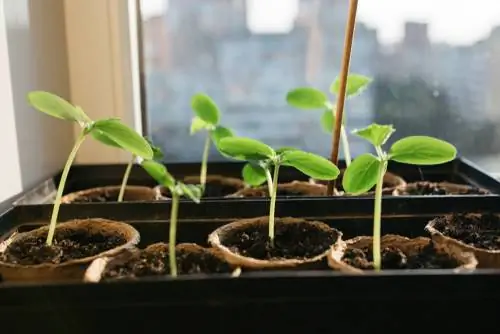
Cucumber plants should be gradually acclimated to the outdoor climate
Not in the planter without drainage
Balcony gardeners always plant cucumbers in pots and balcony boxes with drainage to protect against waterlogging. Before you fill the organic substrate into the planter, cover the bottom with shards of pottery, grit or expanded clay balls. To prevent soil crumbs from getting stuck in the inorganic material, a water- and air-permeable fleece separates drainage and substrate.
The right type of cucumber for every location - an overview
The first step on the way to a lush cucumber harvest is a well-thought-out choice of variety. A general distinction is made between outdoor cucumbers and greenhouse cucumbers. Primarily robust species with a solid shell, often covered with warts or spines, thrive in the bed. For more demanding lettuce or cucumbers, controlled greenhouse conditions are mandatory. These varieties impress with their smooth skin, large fruits and mild taste. If you can't decide, choose a species that is equally impressive outdoors and in the greenhouse. The following table provides an insight into the selection options:
| Greenhouse | special features | Freeland | special features | Greenhouse and outdoors | special features |
|---|---|---|---|---|---|
| Helena | every flower bears fruit, mild taste | Diamond | no mildew, smooth, dark green pickling cucumbers | Solverde | seedless, bitter-free, up to 20 cm long |
| Eiffel | bitter-free, long cucumber, purely female | Iznik | Mini cucumbers, 10 cm long, for pots and balconies | Excelsior | particularly aromatic, tastes fresh and pickled |
| Euphya | resistant, slender fruits up to 35 cm long | Seedcell | perfect cucumber for beginners | Picolino | smooth-skinned snack cucumbers, ideal for pots and balconies |
| Loustik | high yield, 40 cm long, 400-600 g heavy | Green Fingers | mixed flowering, robust, sweet fruit | Jurassic | Primal cucumber, crunchy, 40 cm long, weighs up to 500 g |
| Karim | crunchy, 20 cm long, each flower has one fruit | Delfs No.1 | early variety, 20 cm long, thick-fleshed | Dorninger | green-yellow bowl, 40 cm long |
Growing any type of cucumber in the garden is a home game. The distribution areas of popular Cucumis species from the pumpkin family extend across tropical and subtropical regions. Qualifying as an outdoor cucumber does not imply that it is a hardy variety. Given a minimum temperature of 8 degrees Celsius, all cucumber plants die in the event of frost.
Background
Modern varieties are self-fertile
In many places there is a shortage of growing space in beds and on balconies. This causes headaches for hobby gardeners because historical and tried-and-tested cucumber plants are not self-fertile. Only when a male and female variety grow side by side do female flowers turn into crunchy cucumbers. Ingenious breeders have created modern cucumber varieties that only bear female flowers and fruit reliably without pollination. When purchasing seeds or young plants, pay special attention to this attribute so that all plants give you juicy cucumbers.
How does pre-culture succeed?
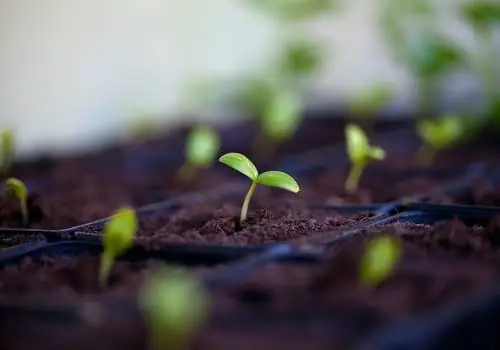
Cucumbers can be brought forward from April
Do you want to accompany your cucumbers from seed to productive plant? The time window for sowing and growing on the windowsill opens in April. In a bright location, the ideal germination temperature is 20 to 25 degrees Celsius. In airy, loose coconut soil and in constantly moist, warm conditions, the seeds transform into vital young plants. How to sow cucumber seeds correctly:
- Soak seeds in chamomile tea or milk for 24 hours
- Fill cultivation pots (from 8 cm in diameter) with seed soil up to half the height
- Press 2 to 3 seeds into the soil for each pot, sieve thinly and water
- Cover with transparent film or put a transparent hood over it
- place bright and warm at least 20 degrees Celsius
- remove cover after germination
- Keep constantly slightly moist and do not fertilize until mid-May
If you don't like sowing them yourself, you can get ready-made young plants from mid-May in garden centers and at weekly markets. Of course, you can also order pre-grown cucumber plants online. Specialist retailers offer many delicious, easy-care varieties as refined cucumbers. Practice has proven that refined seedlings give you more yield thanks to the rootstock's natural resistance to diseases.

When is the best time to plant?
When you can plant cucumbers depends on the cultivation and the location you choose. The following overview summarizes all important dates:
- Sowing windowsill: from the beginning of April
- Direct sowing: beginning/mid-May to beginning of July
- plants in a heated greenhouse: from the beginning/mid of March (unheated from mid/end of April)
- plant outside: mid-May to early July
In the temperature-controlled greenhouse, the window for direct sowing opens in March. For snake cucumbers, this has the particular advantage of an extra long growth period until they are ready for harvest. However, sowing and growing on the windowsill should not begin until the beginning of April at the earliest. Otherwise, the young cucumbers will be far too large for successful planting in beds and raised beds.
Excursus
Direct sowing is a risky undertaking
Cucumbers do not tolerate frost. Rather, the tropical plants breathe their last in cold temperatures below 5 degrees Celsius. During the sowing and cultivation stage, even slight temperature fluctuations cause severe distress to the plants. Direct sowing in gardens north of the Alps therefore carries a high risk of failure. If you're a gardener looking for a challenge, sow small-fruited outdoor cucumbers or hardy pickles directly into the sunny bed from the end of April/beginning of May. A mason jar placed over the top buffers significant fluctuations in outside temperatures.
How much light and heat are required?
Cucumbers are sun worshipers with a preference for moist warmth. For outdoor cucumbers, explicitly choose a wind-protected location in full sun with a soil temperature of more than 15 degrees Celsius. Mini cucumbers thrive in pots on the south-facing balcony with lots of hours of sunshine and pleasant temperatures above 20 degrees Celsius. Large-fruited snake cucumbers require a significantly longer growing season than robust outdoor varieties. Only in combination with warm, tropical conditions in the greenhouse do demanding cucumbers meet the high expectations. Nevertheless, in southern regions, shading from midday onwards is strongly recommended in order to mitigate excessively blazing sun.
What should the earth be like?
Cucumber plants are among the heavy feeders. Choose a location with humus-rich, nutrient-rich soil in the bed and greenhouse. Before planting, work mature compost, well-seasoned horse manure or bark humus into the soil. The high nutrient requirements make cucumbers in raised beds the ideal candidates for initial planting. Please use organic, nutritious vegetable soil without peat in the pot and bucket. The substrate should be loose and well-drained and still have reliable water-holding capacity. A pH value of 6.5 to 7 perfectly rounds off the optimal soil quality outside and under glass.
Trail support is mandatory
Trails are the gardener's secret weapon in the cucumber patch. Fungal diseases and pests have a bad chance when the long shoots grow airily upwards. Ripening fruits dangle at a safe distance from the ground, which effectively prevents the formation of rot. Furthermore, the vertical cultivation area enables a higher yield of crunchy cucumbers. Last but not least, hard-working hobby gardeners really appreciate the back-friendly harvest. The following climbing aids have proven themselves well in beds, greenhouses and pots:
- Narrow bars and rods with a rough surface
- Spiral-shaped plant stick (known from tomato cultivation)
- Vertically installed structural steel mesh or comparable lattice structure
- Wire mesh stretched between wooden posts
- Bamboo sticks tied together to form a teepee
In the greenhouse, ropes act as simple trellises that are fixed to the ceiling. In the large pot, a trellis, pyramid or obelisk made of wooden sticks with a diameter of 20 mm offer the tendrils a place to climb. Instead of using a home-made trellis, it's worth taking a look at the wide range available in garden shops, hardware stores and online shops. The illustration below provides an insight into the many different variants.
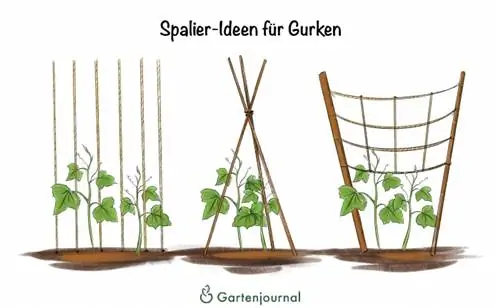
Planting cucumbers in mixed culture - tips & tricks
Mixed culture is highly valued in private kitchen gardens. Home gardeners with a penchant for growing cucumbers are wondering: What can you plant next to cucumbers? Which plants are unpopular as bed neighbors? The following table sheds light on the matter:
| good neighbors | bad neighbors |
|---|---|
| Basil | Potatoes (wilting mushrooms) |
| Comfrey | cabbage |
| Borage | Peppers |
| Dill | Radish |
| Peas | Radish |
| Kale | Beetroot |
| Nasturtium | Sage |
| Carrots | Celery |
| Leek | Sunflowers (shadow casting) |
| Salad | Sweetcorn (shadow casting) |
Good neighbors are over when other pumpkin plants settle next to cucumbers. Members of the same plant family are not well disposed toward each other. Therefore, avoid planting pumpkin, melon or zucchini next to cucumbers.
Planting cucumbers and tomatoes together - this is how it works
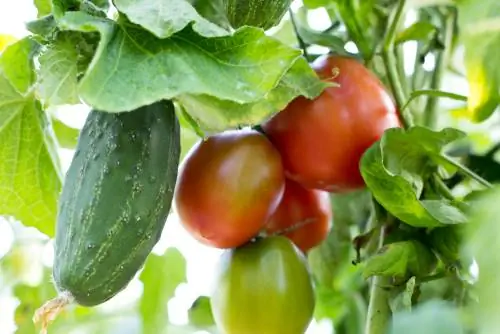
Cucumbers and tomatoes go well together - not just in salads
In the list of recommended planting neighbors for cucumbers, you will look in vain for tomatoes - and for good reason. The requirements for location and care are too different. The warm, humid conditions for cucumbers are pure poison for tomatoes.
With a clever trick you can still keep the two fruit vegetables together under glass. To do this, divide the greenhouse into two climate zones using a partition.
Tips for care and harvesting
Nutrient deficiencies and drought stress cause a bitter taste in cucumbers. The leaves turn yellow in wet soil. Balanced fertilization and regular watering prevent the culinary dilemma. The tipping point is a harvest at the optimal time. Cucumber lovers don't sit back after planting, but devote themselves to these important care measures until harvest:
- Fertilizing in beds and greenhouses: from June onwards, fertilize every 2 weeks with compost, horn shavings or nettle manure
- Fertilizing in the pot: Apply organic liquid fertilizer weekly between fruit setting and harvest
- Watering: if it is dry, water early in the morning with lukewarm water
- Mulching: regularly refresh a thin layer of straw, lawn clippings or compost
- Harvest time: from June in the greenhouse, from July in the open ground
- Harvesting: cut ripe cucumbers with a sharp knife and do not tear them off
How often you water depends on various factors, such as location and weather. You can avoid all imponderables surrounding the water supply with a quick finger test. Press your index finger or thumb an inch into the soil. If there is no moisture in this area, water with stale water.
Tip
Various pathogens reach the leaves of cucumber plants via splash water. This transmission route remains closed to diseases and pests if you remove the lower leaves up to a height of 30 centimeters. You can read about when and how to prune cucumber plants here.
Frequently asked questions
Numerous wilted, dry leaves worry me about my cucumbers, even though I water them regularly. What to do?
If drought stress can be ruled out as the cause, wilted, dried leaves indicate a common plant disease. Cucumber wilt is the name given to infestation with Fusarium oxysporum, a dreaded soil fungus. The pathogens enter the cucumber plant through the soil and clog the supply lines. Remove affected plants from the bed and replace the soil over a large area.
How far apart should you plant cucumbers?
You should ideally plant early young plants at a distance of 40 centimeters within the row. A planting distance of 140 to 170 centimeters between the rows has proven to work well in practice. Shorter distances are not recommended. If cucumber plants come into close contact, diseases and pests are inevitable.
What does the lunar calendar say about planting cucumbers?
The teaching of gardening according to the lunar calendar says that for cucumbers as a fruiting vegetable, a fruit day is more suitable for sowing than a leaf day. To ensure that seedlings take root quickly, note a root day as a date to prick out the plants. If you plant young plants with strong root balls from May onwards, a fruit day will again come into focus. To determine the correct dates, consult a well-maintained online lunar calendar.
Do cucumber plants grow in sun or shade?
Cucumber plants are native to sunny regions from Africa, India, Southeast Asia to India. In order for the tropical pumpkin plants to develop vitally and productively in the Central European climate, they should be able to enjoy at least 6 hours of sunshine a day at temperatures above 20 degrees Celsius. Some leaves may sprout in the shade. However, you will look in vain for flowers or even crunchy cucumbers.
Cucumber plant has yellow leaves - what to do?
If there are lots of yellow leaves hanging on a cucumber plant, there is an urgent need for action. The leaves have the vital task of acting as a control center for the supply of the longed-for fruits. They should be lush green and juicy, instead of bright and yellow. The most common cause of the damage is a lack of nutrients. Between fruit set and harvest, cucumber plants outdoors and in the greenhouse should be supplied with compost and horn shavings every one to two weeks. You can compensate for an acute deficit with nettle manure or an organic liquid fertilizer.
Tip
Like most cucurbits, cucumber plants benefit from occasional pinching. The focus is on majestic snake and cucumbers in the greenhouse. So that the plant energy flows into selected, voluminous fruits, excess flowers are pinched out with your fingers. The effort is not worth it for outdoor cucumbers and mini cucumbers.

